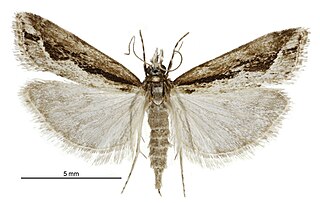
Eudonia steropaea is a species of moth of the family Crambidae. It was named by Edward Meyrick in 1884. Meyrick gave a detailed description of this species in 1885. It is endemic to New Zealand.

Eudonia octophora is a species of moth of the family Crambidae. It was named by Edward Meyrick in 1884. It is endemic to New Zealand.
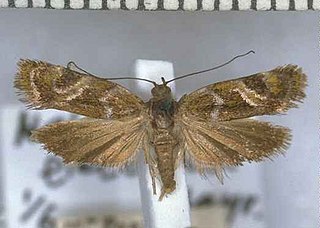
Hierodoris electrica is a moth of the family Oecophoridae. It was described by Edward Meyrick in 1889. It is endemic to New Zealand, where it has been reported from the northern and southern parts of the South Island. The larva of H. electrica has yet to be described. The wingspan is between 15 and 16.5 mm. The ground colour of the forewings is dark brown, with narrow yellow scales overlaying this base colour. The hindwings are brown. The known larval host species is Olearia nummulariifolia.

Eudonia asterisca is a moth in the family Crambidae. It was named by Edward Meyrick in 1884 and is endemic to New Zealand. It has been recorded in both the North and South Islands. This species is recorded as being present at sea level up to altitudes of 1350 m. This species has been recorded as inhabiting native podocarp/hardwood forests. The adults of this species are on the wing from December until March although they have also been recorded in October and November. They are attracted to light and have also been trapped via sugar traps.
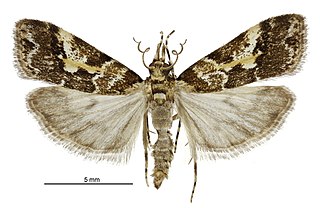
Eudonia characta is a species of moth in the family Crambidae. It was named by Edward Meyrick in 1884 and later more fully described the species. It is endemic to New Zealand.

Eudonia cymatias is a moth in the family Crambidae. It was named by Meyrick in 1884. This species is endemic to New Zealand.
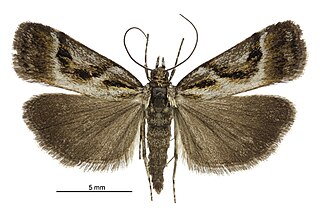
Eudonia hemicycla is a moth in the family Crambidae. It was described by Edward Meyrick in 1884. This species is endemic to New Zealand.

Eudonia legnota is a moth in the family Crambidae. This species was named by Edward Meyrick in 1884. It is endemic to New Zealand.

Eudonia microphthalma is a moth in the family Crambidae. It was described by Edward Meyrick in 1884. It is endemic to New Zealand.

Eudonia oreas is a moth in the family Crambidae. It was named by Edward Meyrick in 1884. This species is endemic to New Zealand.

Eudonia periphanes is a moth in the family Crambidae. It was named by Edward Meyrick in 1884. Meyrick gave a detailed description of this species in 1885. It is endemic to New Zealand.

Eudonia philetaera is a moth in the family Crambidae. It was named by Edward Meyrick in 1884. Meyrick gave a description of the adult moth in 1885. It is endemic to New Zealand.

Eudonia psammitis is a moth in the family Crambidae. It was named by Edward Meyrick in 1884. Meyrick gives a description of the species in 1885. It is endemic to New Zealand, including the Campbell Islands.
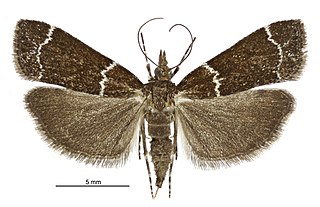
Eudonia leucogramma is a moth in the family Crambidae. This species was first described by Edward Meyrick in 1884. It is endemic to New Zealand.

Eudonia dochmia is a moth in the family Crambidae. It was described by Edward Meyrick in 1905. It is endemic to New Zealand.

Eudonia meliturga is a moth in the family Crambidae. It was described by Edward Meyrick in 1905. This species is endemic to New Zealand.

Eudonia triclera is a moth in the family Crambidae. It was described by Edward Meyrick in 1905. It is endemic to New Zealand.
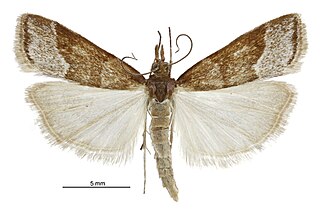
Eudonia feredayi is a moth in the family Crambidae. It was described by Henry Guard Knaggs in 1867. This species is endemic to New Zealand.
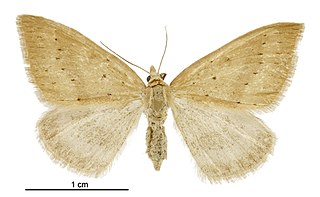
Asaphodes mnesichola is a species of moth in the family Geometridae. It is endemic to New Zealand and has been observed in the South Island. This species inhabits subalpine native scrub. Adults of this species are on the wing in January and February.

Chalastra aristarcha, the silver fern moth, is a moth of the family Geometridae. This species was first described by Edward Meyrick in 1892. It is endemic to New Zealand and is found in the North Island. This species inhabits dense native forest. The larvae feed on the species host plant, the Silver fern, during spring. This species then pupates on top of leaf litter or moss on the ground. The pupation state lasts for approximately 6 weeks. Adult moths are on the wing from October until April but can sometimes also be seen during the winter months. Adults can be disturbed from silver ferns during the day or are seen on the wing at night particularly at Metrosideros perforata when in flower. Adults are attracted to light. It has been hypothesised that the range of C. aristarcha has restricted as a result of urban development and land conversion of its habitat.





















